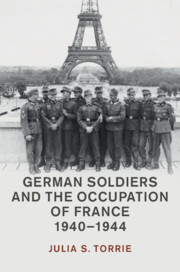Book contents
- German Soldiers and the Occupation of France, 1940–1944
- Studies in the Social and Cultural History of Modern Warfare
- German Soldiers and the Occupation of France, 1940–1944
- Copyright page
- Contents
- Figures
- Acknowledgements
- Abbreviations
- Recurring Personalities
- Map
- Introduction
- 1 Occupations, Past and Present
- 2 Consuming the Tastes and Pleasures of France
- 3 Touring and Writing about Occupied Land
- 4 Capturing Experiences
- 5 Rising Tensions
- 6 Westweich? Perceptions of “Softness” among Soldiers in France
- 7 Twilight of the Gods
- Bibliography
- Index
- References
Bibliography
Published online by Cambridge University Press: 24 September 2018
- German Soldiers and the Occupation of France, 1940–1944
- Studies in the Social and Cultural History of Modern Warfare
- German Soldiers and the Occupation of France, 1940–1944
- Copyright page
- Contents
- Figures
- Acknowledgements
- Abbreviations
- Recurring Personalities
- Map
- Introduction
- 1 Occupations, Past and Present
- 2 Consuming the Tastes and Pleasures of France
- 3 Touring and Writing about Occupied Land
- 4 Capturing Experiences
- 5 Rising Tensions
- 6 Westweich? Perceptions of “Softness” among Soldiers in France
- 7 Twilight of the Gods
- Bibliography
- Index
- References
Summary

- Type
- Chapter
- Information
- German Soldiers and the Occupation of France, 1940–1944 , pp. 252 - 271Publisher: Cambridge University PressPrint publication year: 2018

